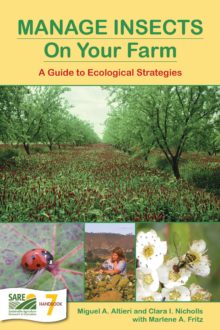Key Elements of Ecological Pest Management
Ecological Pest Management relies on preventive rather than reactive strategies. your cropping program should focus primarily on preventive practices above and below ground (#1 and #2) to build your farm’s natural defenses. Reactive management (#5 and #6) is reserved for problems not solved by the preventive or planned (#3 and #4) strategies.
OVERALL STRATEGIES:
- build the strengths of natural systems into your agricultural landscapeto enhance its inherent pest-fighting capacity.
- enhance the efficiency of your farm, including cycling of nutrients, flow of energy, and/or the use of other resources.
These broad strategies and the individual practices that follow result in systems that are:
- self-regulating — keeping populations of pests within acceptable boundaries
- self-sufficient — with minimal need for “reactive” interventions
- Resistant to stresses such as drought, soil compaction, pest invasions
- Resilient -- with the ability to bounce back from stresses
1) Crop management: above ground habitat conservation and enhancement of biodiversity within and surrounding crop fields. Use a variety of practices or strategies to maintain biodiversity, stress pests and/or enhance beneficial organisms.
- Select appropriate crops for your climate and soil
- Choose pest resistant, local varieties and well adapted cultivars
- Use legume-based crop rotations, alternating botanically unrelated crops
- Use cover crops intensively
- Manage field boundaries and in-field habitats (ecological islands) to attract beneficials, and trap or confuse insect pests
- Use proper sanitation management
- Consider intercropping and agroforestry systems
2) soil management: below ground habitat conservation and enhancement. Build healthy soil and maintain below ground biodiversity to stress pests, enhance beneficials and/or provide the best possible chemical, physical, and biological soil habitat for crops.
- Build and maintain soil organic matter with crop residues, manures and composts
- Reduce soil disturbance (tillage)
- Keep soil covered with crop residue or living plants
- Use cover crops routinely
- Use longer crop rotations to enhance soil microbial populations and break disease, insect and weed cycles
- Maintain nutrient levels that are sufficient for crops but do not cause imbalances in the plant, which can increase susceptibility to insects and diseases
- Maintain appropriate ph
- Control soil erosion and nutrient losses
- Avoid practices that cause soil compaction
3) Planned supplemental pest management practices. The following practices can be used if research and farmer experience indicate that -- despite the use of comprehensive preventive management as outlined above -- some additional specific pest management practices will still be needed:
- Release beneficial insects or apply least environmentally harmful biopesticides
- Prune to reduce humidity in the canopy and deter fungal infections
- Cultivate for weed control based on knowledge of critical competition period
4) Planned supplemental soil practices to reduce crop stress and/or optimize yield and quality
- Maintain adequate soil water content (i.e., with careful irrigation scheduling)
- Mow rather than incorporate orchard cover crops, leaving a mulch cover
- Undersow legumes in cereals
5) Reactive inputs for pest management
If, after following preventive and planned management practices (#1, 2, 3, and 4), pests are above threshold levels and beneficials populations are low, release beneficials or apply selected biopesticides with low environmental impact.
6) Reactive inputs to reduce plant stress
- Use chisel plow or subsoiler to alleviate soil compaction
- Apply nutrients to soil or foliage in response to plant deficiency symptoms
